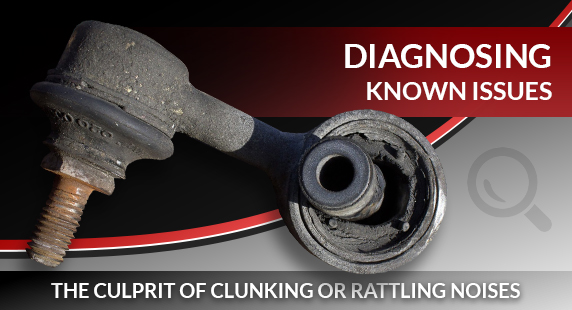Have you noticed clunking, rattling or metal-on-metal scratching noise even after replacing your struts or shocks? The culprit could actually be a $15 part and is typically the cause of your troubles. This part is called the sway bar link.
The responsibility of keeping your car stable and handling smoothly under diverse driving conditions falls on the sway bar. This mechanical unit is attached to the body of the vehicle by way of a body mount with stabilizer bar bushings and the stabilizer bar links, which attach to the lower control arm of the front suspension and have bushings along the link for protection and to ensure a smooth ride.
When the stabilizer bar links are starting to wear out, the symptoms can range from barely noticeable to significant, and if you don't have your stabilizer bar links replaced, can result in catastrophic damage to the front end of your vehicle and potentially an accident.
The stabilizer bar links attach to the lower control arm at the front end of most domestic and foreign vehicles sold within the US. In certain cars, the rear end will also have stabilizer bar links. However, the ones that cause the most damage are in the front and located directly behind your left and right front tires. If you're driving down the road and you start to hear a clunking, rattling or metal-on-metal scratching noise, it is possibly the stabilizer bar links causing the sound.
The stabilizer bar links are supposed to fit incredibly snugly, without any play or movement except between rubber bushings. When the links are worn out, the sway bar will begin to make these sounds especially when you're driving around corners or over a speed bump. When you hear these types of noises coming from the front end of your vehicle, make sure to contact a certified mechanic and have them inspect and replace stabilizer bar links and bushings. This job requires that both the driver and passenger side be completed at the same time.
Since the stabilizer bar links are attached to the lower control arm, steering and handling are also negatively impacted when they begin to wear out. Most of the time, the actual culprit is the bushings that are designed to take the majority of the impact and help to protect the metal parts from wearing out. However, the bushings also can cause extensive corrosion, especially if oil, grease or other debris becomes embedded on the stabilizer bar. The direct result of all of these issues is that the vehicle simply doesn't handle the same way that you're used to. The steering wheel will appear to be "loose", and the body will sway from left to right more due to the fact that the stabilizer bar links and bushings are wearing out.
A great opportunity for car owners to be proactive about keeping their stabilizer bar and front suspension protected from significant damage is to ask a certified mechanic to inspect them during a strut/shock replacement, front brake pad replacement , tire replacement, or other front end work. When they look under the front end, they will also inspect the tie rods, shocks and struts, CV joints and boots along with the front stabilizer bar links, bushings and other front end components. It's a good idea to have the front stabilizer bar links and bushings fully replaced at the same time that other front end work is being completed.
This allows the mechanic to complete an accurate front end suspension alignment, which properly sets the suspension straight, so that the car drives smoothly, wears your tires evenly, and the car doesn't pull to the right or left when you are trying to drive straight.
As with any front end suspension work, it's always best to have a professional and ASE certified mechanic complete your stabilizer bar link replacement


